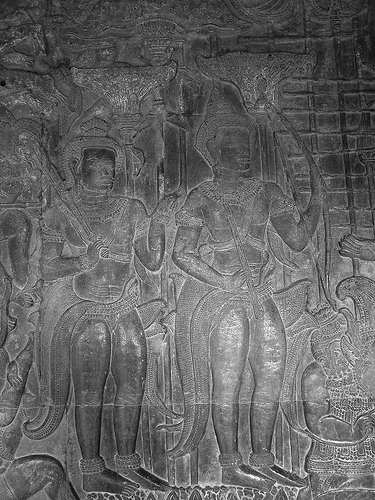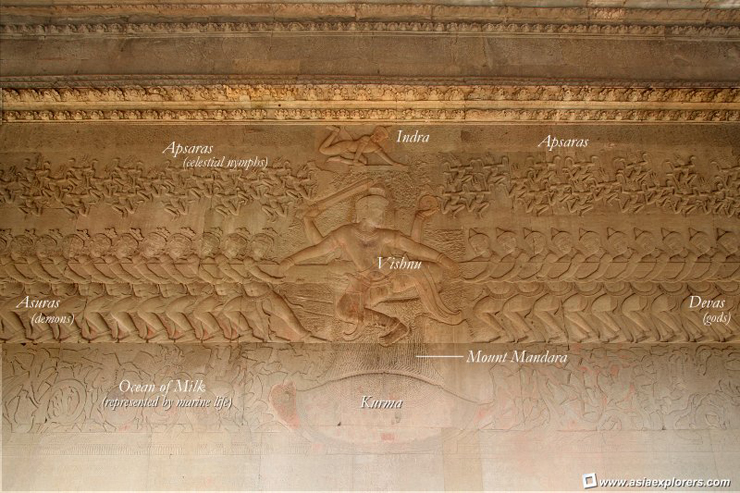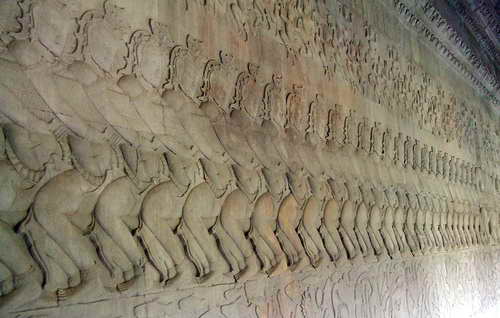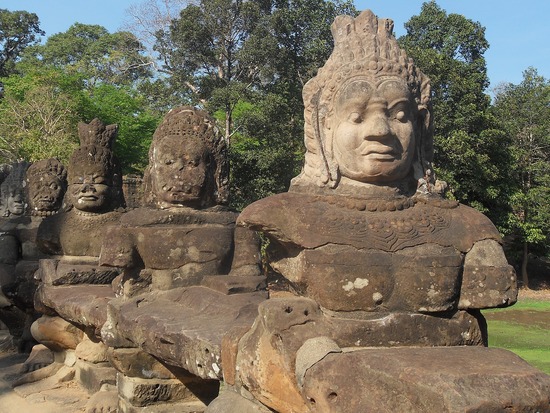Videos on Angkor Wat | Download PDF
Paramavishnuloka is a reference to the memory of the ancestor, Suryavarman II 'he who has reached the realm of Vishnu'. All Suryavarman's ministers and associates are united on Mount S'ivapada. Rajahotar's presence denotes a s'raddha observance (remembering the ancestors). Vrah Vlen 'sacred fire' is carried in an ark on a type of palanquin, preceded by an orchestra.
From S'ivapada of Chams to Vishnuloka of Suryavarman II is a remarkable syncretism of the traditions which have been documented in Indian traditions documented in Pancaratra samhitas (e.g. Sattvata and Ahirbudhnya Samhitas), Ramayana and Mahabharata -- and adapted in Angkor Wat and associated sites of the Cham-Kampuchean-Thai peoples who orgnized themselves into a state, Rajyam governed by dharma-dhamma Hindu-Bauddham continuum.
 Royal sacred power derives from adherance to dharma-dhamma, the eternal, cosmic, universal law. The sacred temples of Angkor are a testament to the sacred power of dharma-dhamma. Ancestors are deified and merit is earned by constructing temples, constructing reservoirs and performing dharmic acts.
Royal sacred power derives from adherance to dharma-dhamma, the eternal, cosmic, universal law. The sacred temples of Angkor are a testament to the sacred power of dharma-dhamma. Ancestors are deified and merit is earned by constructing temples, constructing reservoirs and performing dharmic acts.
From Vishnuloka to S'ivapada, the function of the temple is to depict the steps for final liberation and attainment of Vrah Vishnuloka. This panel is the closest one gets to a s'raddha, an event venerating the ancestors with specific reference to royal associates in King Suryavarman II's reign.
It will be an incomplete representation of the message of the temple to view it as a 'funerary temple' for some kings of ancient Cambodia (cf. George Coedes, 1963,Angkor, an introduction, London, OUP, p. 38). Nor is it valid to record that the parikrama (circumambulation) of the temple praakaara has to be done counter-clockwise because in the Indian historical tradition, Ramayana chronologically precedes Mahabharata.
 Banteay Srei lintel, 10th century. Valin and Sugriva of Ramayana
Banteay Srei lintel, 10th century. Valin and Sugriva of Ramayana

Banteay Srei lintel, tenth century. Ravana shakes Moutn Kailasa. Like Meru, it is shown as a temple-mountain, a pyramid with several layers. S'iva and Parvati are enthroned on top. Below is a row of ascetics, people in masks and animals fleeing in fear.



 Angkor Thom and Angkor Wat depictions of Samudra manthanam
92 asuras, 88 devas pulling the snake Vasuki.
Angkor Thom and Angkor Wat depictions of Samudra manthanam
92 asuras, 88 devas pulling the snake Vasuki.
Both the epics do recount the narrative of Samudra manthanam (churning of the ocean).
The divinity common to both the epics is Hanuman. The parikrama is done as in any Mandiram (temple) clockwise - starting with the Battle of Lanka narrative from Ramayana. Yes, there are narrative panels of Raja Suryarman's army on the march close to the Kurukshetra war narrative panel. This interpolation clearly demonstrates that there is no counter-clockwise parikrama prescribed for the worship in the temple of Angkor Wat.
Like Angkor Wat, there are many Hindu temples in India and in South East Asia which face west:
Prambanan temple has three main temples in the primary yard, namely Vishnu, Brahma, and Shiva temples. Those three temples are symbols of Trimurti in Hindu belief. All of them face to the east. Each main temple has accompanying temple facing to the west, namely Nandini for Shiva, Angsa for Brahma, and Garuda for Vishnu.
| << Previous Page | Next Page >> |
